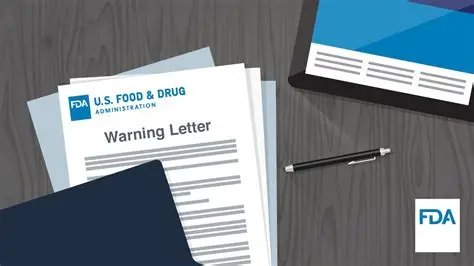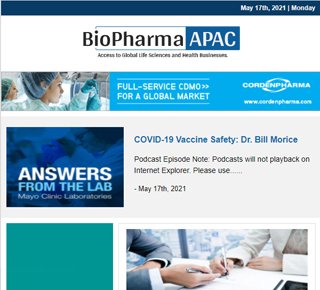FDA’s Most Recent 100 Warning Letters of 2025 Signal Rising Compliance Risks Across Pharma, Biologics, Devices, Food, and Online Markets
11 July 2025 | Friday | Analysis | By BioPharma APAC Desk

Image Source : Public Domain
As of July 2025, the U.S. Food and Drug Administration (FDA) has issued over 3,400 warning letters, with the most recent 100 painting a vivid picture of persistent industry-wide compliance gaps. Spanning pharmaceuticals, medical devices, biologics, human and animal food, tobacco, and online marketplaces, these letters underscore a tightening regulatory landscape and a renewed urgency for inspection readiness.
BioPharma APAC’s analysis of the latest batch reveals key patterns in regulatory enforcement, along with a spotlight on companies and violations that serve as case studies in what to avoid—and how to improve.
Emerging Trends from the Most Recent 100 Letters
1. CDER Dominates Enforcement
-
Nearly half (around 41%) of the warning letters were issued by the Center for Drug Evaluation and Research (CDER).
-
Common violations:
-
CGMP non-compliance across formulation, testing, and documentation.
-
Adulterated finished pharmaceuticals.
-
Unlawful sale of unapproved or misbranded drugs online.
-
Example:
-
Dynamic Blending Specialists, Inc. was cited for CGMP lapses in finished pharmaceuticals, showcasing deficiencies in process validation and batch oversight—typical risks among CDMOs scaling too quickly.
2. Medical Device Sector Under Watch
-
The Center for Devices and Radiological Health (CDRH) issued several letters focusing on:
-
Failure to report adverse events.
-
Quality System Regulation (QSR) violations.
-
Unapproved devices and clinical protocol issues.
-
Example:
-
Insightra Medical Inc. was warned for inadequate medical device reporting and misbranding. This illustrates the importance of robust post-market surveillance and clear labelling for high-risk devices.
3. Surge in E-Commerce Violations
-
Over 15 online entities received warning letters for:
-
Selling unapproved drugs.
-
Selling misbranded tobacco products.
-
Circumventing regulatory oversight by marketing directly to U.S. consumers.
-
Examples:
-
www.buynetmeds.com and shopwithsweet.com were cited for unlawful sales of unapproved prescription drugs.
-
puff21.com and cigarvape.com received letters for tobacco-related violations, including failure to secure marketing authorisations.
4. Biologics and Fertility Clinics in Focus
-
The Center for Biologics Evaluation and Research (CBER) issued warnings to clinics handling Human Cells, Tissues, and Cellular Products (HCT/Ps).
Example:
-
InVia Fertility Specialists, PLLC was flagged for multiple regulatory deviations in HCT/P handling, spotlighting the increasing attention on reproductive medicine and regenerative therapies.
5. Veterinary and Animal Feed Risks
-
Several letters came from the Center for Veterinary Medicine (CVM) for food adulteration and unsanitary manufacturing practices.
Examples:
-
J.D. Heiskell Holdings LLC and Lystn LLC (Answers Pet Food) were cited for processing pet foods under insanitary conditions, raising concerns about zoonotic risks and contamination.
6. Human Food and Agriculture Still Falling Short
-
The Human Foods Program flagged multiple cases for:
-
Shell egg regulation violations.
-
Lapses in hazard analysis and risk-based preventive controls.
-
CGMP failures in food preparation and packaging.
-
Example:
-
Voehlganic Farm LLC was cited for violating the PHS Act due to poor handling of shell eggs.
? Company Highlights from the Most Recent Warning Letters
| Company Name | Sector | Issuing Office | Violation Summary |
|---|---|---|---|
| Dynamic Blending Specialists | Pharmaceuticals | CDER | CGMP violations in finished drug production |
| Insightra Medical Inc. | Medical Devices | CDRH | Adverse event reporting failures and misbranding |
| InVia Fertility Specialists, PLLC | Biologics | CBER | HCT/P regulatory deviations |
| J.D. Heiskell Holdings LLC | Animal Feed | CVM | CGMP violations; insanitary conditions |
| Lystn LLC (Answers Pet Food) | Pet Food | CVM | Adulterated food; production under unsanitary conditions |
| www.buynetmeds.com | E-commerce Pharmacy | CDER | Unapproved drug sales online |
| puff21.com / bestvape.com | Tobacco Products | CTP | Misbranding, marketing without FDA authorisation |
| Voehlganic Farm LLC | Food Production | Human Foods | Shell egg regulation violations under the PHS Act |
| Xtreme Tools International, Inc. | Pharmaceuticals | CDER | Adulterated product; CGMP failures |
| Libby Laboratories, Inc. | Pharmaceuticals | CDER | Adulteration; poor quality control processes |
FDA’s Enforcement Split (Most Recent 100 Letters)
| Regulatory Division | Approximate Share |
|---|---|
| CDER (Drugs) | 41% |
| CTP (Tobacco) | 20% |
| Human Foods Program | 18% |
| CDRH (Devices) | 14% |
| CBER (Biologics) | 3% |
| CVM (Veterinary/Animal Feed) | 3% |
| Division of Imports / FSVP | 1% |
Key Lessons for Industry Stakeholders
-
1. Year-Round Inspection Readiness Is No Longer Optional
The FDA’s latest warning letters expose deep-rooted issues in quality oversight and operational discipline. Too many companies approach compliance reactively—only when inspections loom.
“FDA inspections today are intelligence-led, and companies must be audit-ready at all times—not just during inspection windows,”
said a spokesperson from a global regulatory affairs consultancy.Recommended Action: Implement mock inspections and dynamic audit schedules that reflect FDA's evolving inspection triggers, including whistleblowing and supply chain traceability concerns.
2. Online Sellers and CDMOs Are Facing Heightened Scrutiny
From unlicensed drug sales to GMP lapses in contract development, the FDA is holding online distributors and third-party manufacturers to account more than ever before.
“Digital product sales and contract manufacturing can no longer operate in regulatory blind spots. They are now squarely under FDA surveillance,”
noted a spokesperson from an Asia-Pacific-based compliance intelligence firm.Recommended Action: Integrate regulatory checks into digital sales workflows, and enforce full QA oversight across outsourced production—especially for label claims and documentation.
3. Post-Market Vigilance Is Now a Strategic Priority
Device makers and biologics developers were cited for failing to report adverse events or deviations in clinical material handling—mistakes with serious downstream consequences.
“Post-market oversight should be embedded into product life cycle strategies. It’s not a back-end activity; it’s a frontline defence mechanism,”
emphasised a spokesperson from a global medical device regulatory board.Recommended Action: Formalise a post-market review process that draws on real-world evidence, complaint data, and safety monitoring, with cross-functional escalation procedures.
4. Regulatory Literacy Must Extend Across the Organisation
The root cause of many violations—ranging from food handling breaches to GMP failures—was a lack of frontline awareness of regulatory responsibilities.
“If compliance knowledge is siloed within quality teams, the organisation is at risk. Everyone must speak the language of regulation,”
said a spokesperson from a US-based GMP training institute.Recommended Action: Conduct role-specific compliance education that ties individual functions to real-world warning letter case studies. Reinforce learning through on-the-floor simulations.
5. Public Transparency Is Becoming a Brand Imperative
FDA warning letters are published publicly and frequently cited by media and investors. A company’s response to such notices now carries significant reputational weight.
“How a company responds to regulatory action often matters more than the infraction itself. Transparency and accountability are now brand currencies,”
stated a spokesperson from a leading life sciences investment firm.Recommended Action: Prepare external communication protocols for responding to FDA actions. Issue CAPA summaries proactively and align your investor relations with compliance narratives.
6. Overseas Suppliers Must Meet U.S. Standards—No Exceptions
Multiple foreign firms were cited under the Foreign Supplier Verification Program (FSVP), revealing persistent gaps in aligning local practices with U.S. expectations.
“Exporters often comply with domestic standards but fall short of FDA’s global GMP rigor. Cross-border harmonisation is a must,”
affirmed a spokesperson from a European regulatory affairs platform.Recommended Action: Appoint U.S.-based compliance liaisons for foreign operations, and audit every link in the supply chain with FDA standards in mind.
A Time for Proactive Compliance Culture
The most recent 100 FDA warning letters in 2025 reveal an agency that is not only enforcing compliance more broadly—but also more aggressively across digital and international channels. For life sciences firms, biologics clinics, food producers, and device manufacturers, the path forward is clear: integrate compliance into every step of the lifecycle.
From CGMP training and data integrity to digital due diligence, the industry must build a culture of quality or risk falling behind—publicly, legally, and commercially.
Most Read
- Using NLP-Driven Decision Support in Emergency Health Assistance
- Taiwan Steps Into the Global Spotlight With a New Cancer Therapy
- The Role of Unique Device Identification (UDI) in Tracing Medical Device Safety
- The Importance of a Patient’s Mental Health During Clinical Trials
- Bridging the Vision Gap: Roche’s Ahmed Elhusseiny on Eye Health Priorities in Asia Pacific
- How Merck’s India-Based Navi Mumbai Centre is Reimagining Formulation Science for the Global Generics Market
- Advancing Cell & Gene Therapy in APJ: How Thermo Fisher Enables Breakthrough Innovation
- AstraZeneca’s Vision for Chronic Kidney Disease: Sylvia Varela on Transforming CKD Care in Asia
Bio Jobs
- Ravindra Rao Joins GOBI Technologies as Director of Life Sciences – APAC
- Amgen Announces $900 Million Expansion of Ohio Biomanufacturing Facility, Boosting Investment to Over $1.4 Billion
- Thermo Fisher Scientific Appoints Former CVS Health CEO Karen S. Lynch to Board of Directors
- Merck KGaA Reshapes Leadership for the Future with Key Executive Moves
- Aarian Health Appoints Thomas Keller as Business Director to Drive Innovation and Growth
- Top Management Shakeups of 2024: Redefining Pharma, Biopharma, and Biotech Leadership
News
Editor Picks











